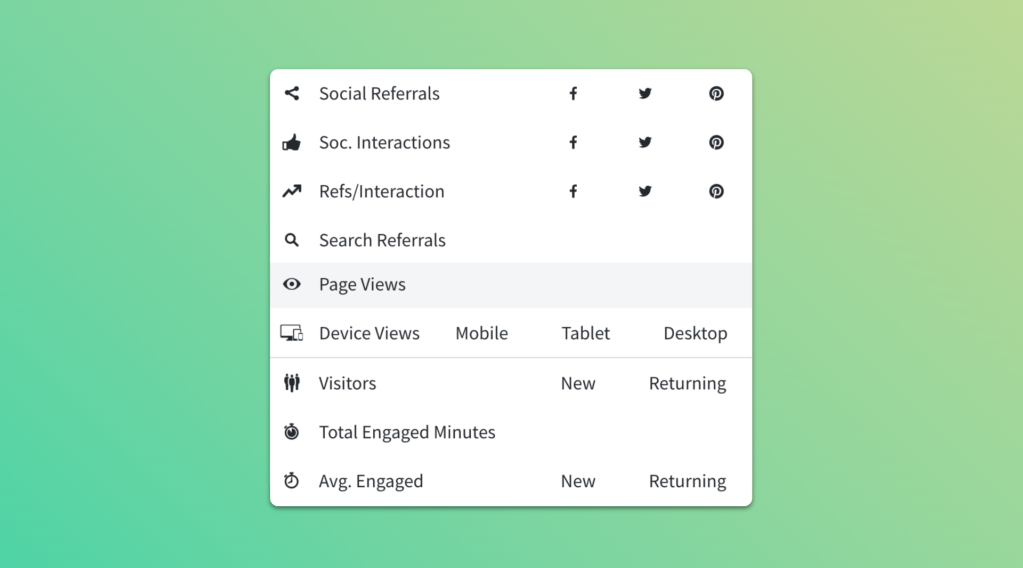5 Metrics That Add Meaning and Context to Pageviews

Pageviews are one of the oldest and most widely-accepted metrics for content. They’re a useful measurement for any content team, but they’re subject to a lot of noise.
Table of contents
What are the benefits of tracking pageviews?
Pageviews offer a chance to make an impression on visitors, develop a deeper relationship with them, and strengthen your brand equity.
Tracking pageviews is common practice for content teams focused on the awareness stage of their funnel, where the goal is audience growth. The same goes for any campaign or content where total reach is the primary goal. In those cases, high pageview numbers means wide audience reach.
At the very least, pageviews help you prove that you raised brand awareness. At the very best, they help you prove that you moved visitors one step closer toward conversion.
Pageviews can also be useful for assessing differences in how your content is reaching audiences on different channels. For example, if you see more people visiting your site on their desktops than their mobile devices, you may want to investigate if there are design issues that make your mobile site difficult to use.
What are the drawbacks of tracking pageviews?
Yes, pageviews are worth tracking. But there are significant considerations to make when dealing with this noisy metric.
Keep in mind two things when tracking pageviews as a metric for success:
- It’s easy to fall into the trap of artificially boosting your numbers through paid traffic or using gimmicky presentations like slideshows. This will raise your pageview count but likely won’t impact your company’s bottom line.
- Pageviews don’t tell you much on their own. They are much more useful when used alongside other metrics that provide more context about how well your content is performing.
Pageviews in combination with other metrics
So how do we make our pageview numbers more meaningful? Simply add context.
Pageviews measure awareness, but they need to be used alongside other metrics to grasp whether visitors are not just aware of your content, but engaged with it.
Five metrics that add meaning and context to pageviews
1. Visitors
Look at the ratio of pageviews compared to visitors to identify how many pages each person is looking at, on average. If you see a high ratio of pageviews per visitor, it’s likely they are more engaged with your content.

2. Engaged time
Add nuance to how well a page is performing by looking at engaged time alongside pageviews. After all, having lots of people land on a page isn’t very useful if those visitors don’t like what they see and leave right away.

3. New and returning visitors
Looking at the kinds of visitors viewing your page can give you clues about who finds it helpful and why.
For example, if you see a piece of content getting pageviews primarily from returning visitors, that might mean it’s a useful reference for loyal leaders—a beloved evergreen article that has aged well.
Pages visited primarily by new visitors are successfully building your audience and extending your reach.

4. Geographic location
Combine pageviews and geographic location to identify trends in how audiences from different parts of the world engage with your content. You might discover you have an untapped market.

5. Source referral
Combine pageviews and source referral to get a better idea of what content to promote on which channels. This can offer insight into differences in interest and perspectives, ideal content format, etc., based on the channel.

How to get more pageviews
The best way to get more pageviews is to create content that delivers more value to visitors.
First, analyze search intent. Your content needs to answer your readers’ questions. Use keyword research to home in on the most important answers you can provide your audience.
Also, pay attention to what format makes sense for your answer. Sometimes, readers want a longform blog post; other times an infographic or a video.
When you find content that is performing well, don’t reinvent the wheel. Use Parse.ly’s evergreen content report to uncover existing content that your readers value and use that as a springboard to create more pieces on that topic.
Metrics like engaged time are also strong indicators that visitors like a piece of content and want to see more of it.
Getting more pageviews is not just about the content itself. It’s also about making it easy for both users and search engines to find and digest that content. To please search engines, use keywords and secondary keywords in titles, headings, meta descriptions, and alt-image text. Use internal links that point to similar content.
For a better user experience, experiment with different fonts, colors, content structures, and navigation bars.
How can Parse.ly help?
Pageviews are the foundation of good content analysis. But the metric alone does not show the full picture.
Parse.ly provides context around pageviews at every step of your content analytics workflows. On every page of the Parse.ly dashboard, there are “context” sections that help you react quickly and effectively to signals in pageview data.
Need some help putting context behind your pageviews?